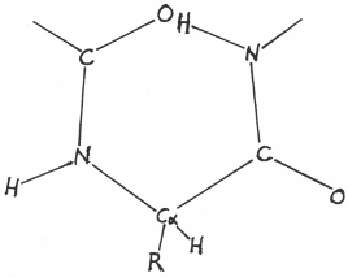Biology Reference
In-Depth Information
For example, consider in the new convention (Fig. 5-9). The O
bounded to C., and the H bounded to N
+1
are separated by less than 0.2 A (<
2.2 A). This configuration is thus sterically hindered.
Figure 5-9.
Configuration for
in the new convention.
Regardless of whether the old or new convention is used for and angles,
the same Ramanchandran plot is used by all researchers for ranges of
0
0
to 360
0
in the old convention and -180
0
to +180
0
in the new convention
(Fig. 5-10). The configurations represented by (0
0
,0
0
) and (-103
0
,+41
0
) in
the new convention are plotted. The point represented by (0
0
,0
0
) has bad
steric hindrance as mentioned above. The other point, (-103
0
,+41
0
),
presumably should be sterically allowed, since it is found in one of the
structures of a protein.
The steric hindrance calculations used by Ramakrishnan and Ramachandran
(1965) are, however, totally independent of X-ray diffraction studies of
proteins. Thus, they provide a different aspect for the study of protein
configurations. The distances between any two non-bounded atoms can be
calculated from the angles and the bound distances and angles of a
standard peptide, and compared with the minimum contact distances listed
in Table 5-4 as to whether they are allowed.












